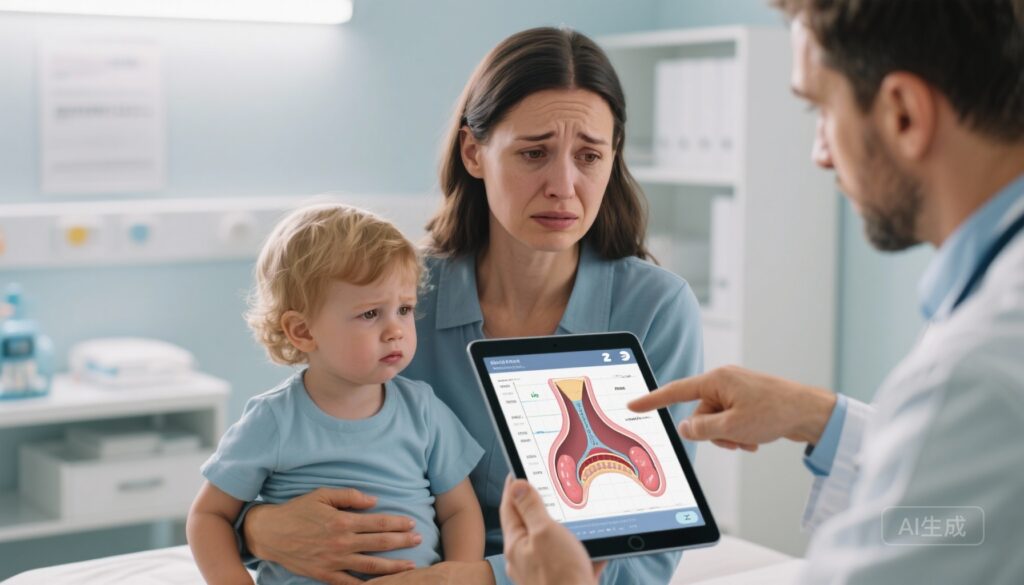Highlights
– The Karolinska Adenotonsillectomy (KATE) randomized clinical trial compared adenotonsillectomy (ATE) with watchful waiting (WW) in otherwise healthy children aged 2–4 years with OAHI 2–<10 over 3 years.
– No significant difference in change in obstructive apnea–hypopnea index (OAHI) between groups (Cohen d 0.05; 95% CI, -0.7 to 0.6).
– ATE produced a medium-sized but statistically inconclusive improvement in disease-specific quality of life (OSA-18; Cohen d 0.54; 95% CI, -1.3 to 0.1).
– 13 of 31 children (42%) randomized to WW crossed over to surgery; those children had worse baseline OSA, larger tonsils, and poorer OSA-18 scores.
Background and clinical context
Pediatric obstructive sleep apnea (OSA) is caused most commonly by adenotonsillar hypertrophy and affects behavior, growth, cardiovascular function, and quality of life. Adenotonsillectomy (ATE) is widely considered the primary treatment for otherwise healthy children with OSA. However, the natural history of mild pediatric OSA and the magnitude and durability of benefit from immediate surgery versus conservative management (watchful waiting, WW) has been debated, with implications for shared decision-making and resource use.
Prior randomized data include the Childhood Adenotonsillectomy Trial (CHAT; Marcus et al., NEJM 2013), which enrolled children 5–9 years old and found improvements in behavior and quality of life but no significant change in attention/executive function at 7 months. Long-term randomized evidence in younger children is limited. The Karolinska Adenotonsillectomy (KATE) trial addresses this gap by studying 2–4-year-olds with mild to moderate OSA over a 3-year period.
Study design
The KATE randomized clinical trial (Sjölander et al., JAMA Otolaryngol Head Neck Surg. 2025) enrolled 60 otherwise healthy children aged 2–4 years with polysomnographically measured obstructive apnea–hypopnea index (OAHI) ≥2 and <10 at a single tertiary center (Karolinska University Hospital, Stockholm). Participants were randomized to adenotonsillectomy (ATE; n = 29) or watchful waiting (WW; n = 31). The WW arm had predefined criteria for crossover to surgery: ongoing signs of OSA with OAHI >1 and/or severe symptoms. Primary outcome was the between-group difference in change in OAHI from baseline to 3 years. Secondary endpoints included the OSA-18 quality-of-life questionnaire and safety outcomes. Data collection and analyses were completed in 2023; 3-year follow-up was achieved for most participants.
Key findings
Study flow and analysis sets
Of 60 randomized children, 48 (80%) completed the 3-year follow-up: 23 of 29 in the ATE arm and 25 of 31 in the WW arm. Because children in the WW arm who crossed over to surgery (n = 13; 42% of WW) were excluded from the per-protocol analysis, the per-protocol sample comprised 39 children (23 ATE, 16 WW nonoperated).
Primary outcome: polysomnographic OAHI
The predefined primary comparison — the between-group difference in change in OAHI over 3 years — showed no meaningful difference. The reported effect size was Cohen d 0.05 (95% CI, -0.7 to 0.6), indicating essentially no difference in OAHI trajectory between randomized groups in the intention-to-treat context. This result implies that, in this small trial, immediate ATE did not reduce the long-term OAHI more than an initial strategy of watchful waiting when averaged across all randomized participants.
Secondary outcome: disease-specific quality of life (OSA-18)
There was a medium-sized effect favoring ATE for change in total OSA-18 score (Cohen d 0.54). However, the 95% CI reported (-1.3 to 0.1) crosses zero, indicating statistical uncertainty around the point estimate. Clinically, families reported greater symptom and quality-of-life benefit after ATE compared with the subset of WW children who did not undergo surgery, but the small sample and wide confidence intervals temper definitive conclusions.
Crossovers and predictors of later surgery
Thirteen of 31 children (42%) randomized to WW crossed over to surgical treatment during follow-up. Of those, nine had follow-up polysomnography after ATE demonstrating normalized OAHI. Compared with WW children who did not undergo surgery, crossover children had worse baseline measures: more frequently moderate OSA (effect size Cohen d 0.8), higher OSA-18 scores (Cohen d 0.8), and larger tonsils (Cohen d 1.3). These findings suggest that clinical severity and tonsil size at baseline predicted subsequent need for surgery under a watchful-waiting strategy.
Safety and adverse events
The published report focuses on efficacy and long-term outcomes; standard perioperative risks of adenotonsillectomy (bleeding, anesthetic complications, dehydration, pain) apply and were monitored. No unexpected safety signals were reported in the trial publication. The WW group avoided surgical risks until and unless crossover thresholds were met.
Interpretation and expert commentary
The KATE trial provides important long-term randomized data in a younger pediatric cohort with mild to moderate OSA. Its principal takeaways are twofold. First, averaged across randomized children, immediate ATE did not produce superior long-term polysomnographic improvement compared with initial watchful waiting. Second, a substantial minority (≈42%) of children assigned to watchful waiting later underwent surgery—largely those with worse OSA severity and larger tonsils at baseline—and these children tended to have normalized OAHI after ATE.
How does this fit with prior evidence? The CHAT trial (Marcus et al., NEJM 2013) showed that ATE improved behavior and quality of life in 5–9-year-olds at 7 months, but it included an older age group and had shorter follow-up. KATE complements CHAT by studying younger children and extending follow-up to 3 years, a timeframe more likely to capture the natural history of adenotonsillar tissue regression and delayed clinical decisions.
Clinically, the KATE results support a nuanced, individualized approach: for otherwise healthy toddlers with only mild OSA and small tonsils, a strategy of watchful waiting with planned follow-up (clinical reassessment and targeted polysomnography when symptoms persist) is reasonable and avoids immediate exposure to surgical risk for many. However, for children with moderate OSA, larger tonsils, or more significant symptom burden, early ATE remains appropriate, given the higher likelihood of persistent disease and later need for surgery.
Limitations and generalizability
Important limitations constrain how broadly KATE should change practice. The trial is small (n=60) and single-center, leading to wide confidence intervals and a risk of type II error for small-to-moderate effects. A large crossover rate in the WW arm complicates per-protocol analyses and is an expected challenge in surgical trials. The study enrolled otherwise healthy 2–4-year-olds with OAHI 2–<10; findings are not generalizable to older children, infants, or those with comorbidities (obesity, craniofacial syndromes, neuromuscular disease) who often have different risk–benefit profiles and higher baseline severity. Finally, the OSA-18 improvement favored ATE numerically, but the CI included no effect; the trial may have been underpowered to detect clinically meaningful quality-of-life differences.
Practical implications for clinicians
– Shared decision-making: Discuss with families the trade-offs between immediate symptom relief and surgical risks versus a monitored WW approach that may avoid surgery for many but will require reliable follow-up and clear thresholds for intervention.
– Risk stratification: Consider baseline OAHI severity, tonsil size, symptom burden, and family preference. Children with moderate OSA, larger tonsils, or marked symptom-related impairment are more likely to benefit from early ATE.
– Follow-up strategy: For children managed with WW, schedule clinical reassessment and consider repeat polysomnography when symptoms persist or worsen. KATE used OAHI >1 and/or severe symptoms as criteria prompting surgery; local practice may adapt similar thresholds.
Conclusion
The KATE randomized trial adds valuable long-term data to the evidence base for management of mild to moderate pediatric OSA in toddlers. Immediate adenotonsillectomy did not demonstrate superiority over initial watchful waiting in change in OAHI at 3 years across the randomized cohort, but ATE produced greater improvements in disease-specific quality of life and reliably normalized OAHI when performed after crossover. These results support watchful waiting as a reasonable option for carefully selected young children with mild OSA and small tonsils, provided there is structured follow-up and clear criteria for proceeding to surgery. Larger multicenter trials would be helpful to refine thresholds for intervention and identify subgroups most likely to benefit from early surgery.
Funding and trial registration
Trial registration: ClinicalTrials.gov Identifier: NCT02315911. Funding sources were reported in the original publication (Sjölander I et al., JAMA Otolaryngol Head Neck Surg. 2025); refer to the article for details.
Key references
– Sjölander I, Fehrm J, Borgström A, Nerfeldt P, Friberg D. Adenotonsillectomy vs Watchful Waiting in Pediatric Mild to Moderate Obstructive Sleep Apnea: The KATE Randomized Clinical Trial. JAMA Otolaryngol Head Neck Surg. 2025 Nov 1;151(11):1038-1045. doi: 10.1001/jamaoto.2025.2831. PMID: 40965870; PMCID: PMC12447282.
– Marcus CL, Moore RH, Rosen CL, et al.; Childhood Adenotonsillectomy Trial (CHAT) Research Group. A randomized trial of adenotonsillectomy for childhood sleep apnea. N Engl J Med. 2013 Aug 22;369(5): 428-36. doi:10.1056/NEJMoa1301 9 (Marcus et al., NEJM 2013 provides landmark randomized evidence on ATE vs WW in older children).
– American Academy of Pediatrics. Clinical practice guideline: diagnosis and management of childhood obstructive sleep-disordered breathing. Pediatrics. 2012;130(3):e714-e755. (Provides context on evaluation and indications for adenotonsillectomy in children.)
For clinicians seeking to translate KATE into practice: prioritize individualized risk assessment, transparent family discussion, and robust surveillance when electing watchful waiting in young children with mild OSA.


